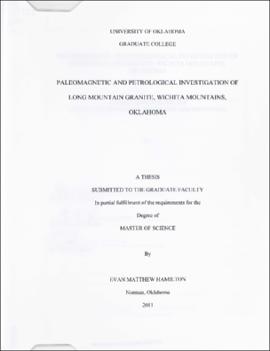| dc.contributor.author | Hamilton, Evan Matthew | |
| dc.coverage.spatial | Oklahoma | |
| dc.coverage.spatial | Wichita Mountains | |
| dc.coverage.spatial | Oklahoma | |
| dc.coverage.spatial | Wichita Mountains | |
| dc.coverage.spatial | Oklahoma | |
| dc.coverage.spatial | Wichita Mountains | |
| dc.date.accessioned | 2021-01-13T18:00:24Z | |
| dc.date.available | 2021-01-13T18:00:24Z | |
| dc.date.created | 2011 | |
| dc.date.issued | 2011 | |
| dc.identifier.uri | https://hdl.handle.net/11244/326822 | |
| dc.description | Thesis (M.S.)--University of Oklahoma, 2011 | |
| dc.description | Includes bibliographical references (leaves 100-110) | |
| dc.description.abstract | The Long Mountain Granite, a member of the Cambrian- aged Wichita Granite Group, is exposed in the western Wichita Mountains. The rock is red at the surface which grades into a dark gray to green core that has been exposed by quarrying operations. The Long Mountain Granite is a highly granophyric, fluorite- bearing alkali feldspar granite with hedenbergite as the dominant magic phase. The formation of red granite is not associated with significant geochemical change. Hematite occurs as fracture fill, grain boundary coatings and as slivers inserted along cleavage and exsolution planes in alkali feldspars. The Fe in the hematite appears to be sourced from the oxidation of magnetie and ilmenite and the breakdown of magic minerals.
Anisotropy of magnetic susceptibility analysis shows that the green granite contains what appears to be a primary magnetic fabric that is consistent with the sill- like emplacement of Wichita-group granites. Demagnetization yields a characteristic remanent magnetization (ChRM) with a pole at 8.8 °S, 134.7°E. This is interpreted as a primary Cambrian thermal remanent magnetization residing in magnetite, and is
consistent with several other paleomagnetic poles of similar age, providing a new constraint to the Cambrian apparent polar wander path (APWP) for Laurentia.
Red granite has approximately two orders of magnitude lower magnetic susceptibility and natural remanent intensity. The degree of magnetic anisotropy is reduced relative to green granite and the fabrics are incompatible. The ChRM of red granite yields a paleopole at 44.9 °N , 124 .9°E and is interpreted as a chemical remanent magnetization residing in hematite. This pole is consistent with the late Paleozoic segment of the North American APWP and is consistent with inferred timing of uplift or exposure. Alteration was likely caused by fluid interactions during this time, either by high-temperature fluids mobilized by uplift or by low-temperature weathering fluids while exposed at the surface. | |
| dc.format.extent | x, 121 leaves | |
| dc.format.medium | x, 121 leaves : ill. (some col.), maps (chiefly col.) ; 29 cm. | |
| dc.language.iso | eng | |
| dc.subject.lcsh | Granite--Oklahoma--Wichita Mountains | |
| dc.subject.lcsh | Petroleum--Geology--Oklahoma--Wichita Mountains | |
| dc.subject.lcsh | Paleomagnetism--Oklahoma--Wichita Mountains | |
| dc.title | Paleomagnetic and petrological investigation of Long Mountain Granite, Wichita Mountains, Oklahoma | |
| dc.type | Text | |
| dc.contributor.committeeMember | David London | |
| dc.contributor.committeeMember | R. Douglas Elmore | |
| dc.contributor.committeeMember | Barry L. Weaver | |
